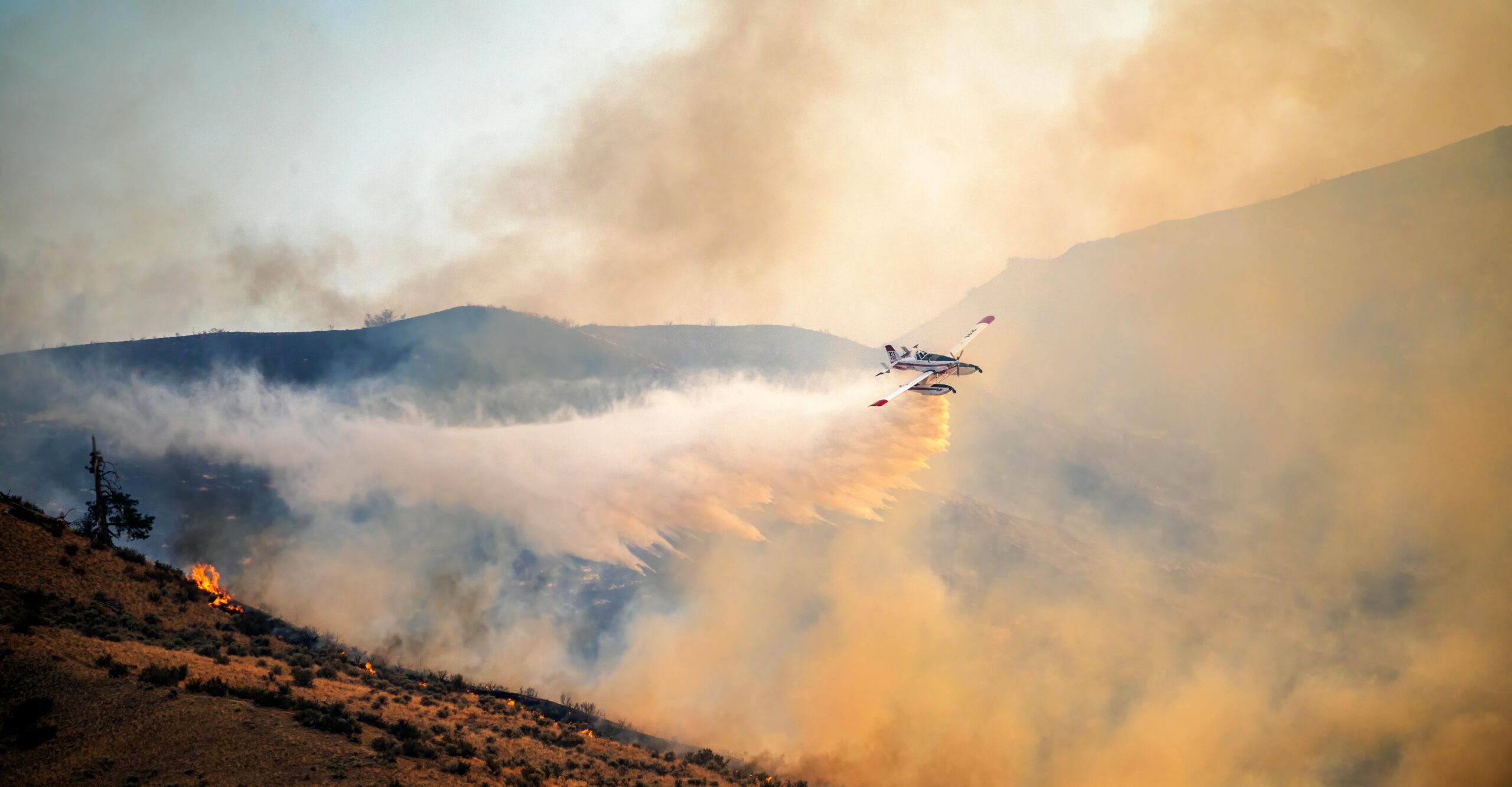By: Isabelle Crow
Tracy Zedeck the Initial Attack Captain of the CL415 Super Scooper, Mike Downing the First Officer of Dash 8-400AT and Chris Niemann, General Manager at Aero-Flite discuss a career in aerial firefighting and looking to the future
Can you introduce yourself and describe your role and background in aerial firefighting?
Tracy: Prior to joining aerial firefighting, I towed gliders in Colorado, flew glacier tours in Denali National Park, piloted charter flights in California and performed seaplane operations in the Maldives and Croatia. When the recession hit in 2009, I returned to school to add an Airframe and Powerplant License to my credentials.
During one class we were shown a video of a Skycrane helicopter dropping water over a fire. Seeing that I could combine my passion for aviation with helping others, that’s when I knew aerial firefighting was what I wanted to do.
I have been working with the Aero-Flite team since 2016. It is a rewarding experience, responding to wildfires across the country and amphibious aircraft are a lot of fun to fly! I enjoy the variety and challenges of the environment in which we get to fly in.
Each day I never know where I’m going to go or what the water source (lakes, rivers) will be like. Even for repeat locations the environment is constantly changing, whether it be the wind direction (scooping towards/away from terrain), wind strength (calm/rough water), recreational use (boat traffic few/many), etc. It’s an adventure to say the least and I’m grateful for the opportunity every day.
Mike: I served 22 years in army aviation, most of my career traveling the world as a special operations Blackhawk pilot. During my final two years, I flew the C-27J and Casa 212 in support of the military free fall school in Yuma, AZ. I grew up in Oregon where wildfires are a common threat each summer, devastating for many communities. I was always interested in wildland firefighting and after retiring from army aviation, it seemed like a natural fit to go into aerial firefighting.
Last season I worked fires in the western US, from Washington and Montan, to Wyoming and Arizona. I even flew missions in my home state. The culmination of my first year at Aero-Flite was deploying to southern California in January to fight the Palisades Fire in Los Angeles. It was a true test of my first year as an aerial firefighting pilot- operating a new aircraft on a complex urban fire with challenging hazards and terrain, all in some of our nation’s busiest airspace. The destruction was heartbreaking. It felt good to have made a difference, even if only a small one.
What makes Aero-Flite’s aircraft effective for wildfire support and ground crew coordination?
Tracy: From a mission standpoint, I think one of the best advantages for flying the scooper is that we can stay on scene for an approximately 4.5 hour fuel cycle. When the fire is right next to a water source we can scoop 1,621 gallons for each drop and do as fast as 2 minute turn-arounds. That’s a lot of water!
The Q400, the Dash 8-400AT’s nickname, is a very versatile platform, offering a lot of power from two turbo prop engines. It has record breaking speed taking off and can fly as fast a jet to a fire. Plus, the turbo prop engines make it very maneuverable, with excellent slow and low flying capability, plus handling in any terrain including mountains. The bonus is its fuel efficiency. Not just a cost saving, we can drop more payload for fuel burned than other similar size tankers.
This means we can help ground firefighters longer, responding with more retardant. It’s a smaller size large airtanker that makes a substantial impact on all fronts and is fun to fly.
Can you give a brief overview of Aero-Flite’s history and mission?
Chris: Aero-Flite was founded in 1963 by airtanker pilots and brothers Ray and John Elgin, who flew the B-17. A lot has happened in 62 years since then!
The company moved from Wyoming to Arizona before putting roots in Spokane, Washington, where we are currently based. The fleet grew to include DC-4s before modernizing with the aircraft we use today, including the CL415 water scooper, RJ85 airtanker and Dash 8-400AT airtanker. We now own and operate 15 large aerial firefighting aircraft, one of the largest privately-owned fleets in the US, responding to fires across the country. Our team has grown from 2 to nearly 250 skilled aviation professions including pilots, mechanics and support teams, who work year-round to make sure our aircraft are ready to respond when needed.
Our aircraft are contracted by state and federal agencies, on multi day, long term agreements. These agencies call upon the fleet when needed, directing our groups where and when to drop. During the peak wildfire period, our aircraft could travel to a different state each day, depending on where fires are occurring. They operate out of airtanker bases situated close to where wildfires are burning for a faster response. The contracting agencies strategize the tactics while our team executes the mission.
Our aircraft suppress wildfires, either by slowing flames using retardant or by cooling flames using water. They respond with a fast initial attack, hopefully catching a fire before it becomes uncontrollable. A fast first response, followed by sustained action, gives firefighters on the ground time to contain the fire. The aircraft are in a supporting role for the ground firefighters that ultimately put the fires out. It takes a team to be successful.
How has Aero-Flite adapted to environmental, regulatory, and logistical firefighting challenges?
Chris: We are definitely seeing changes. We used to be operational for eight to nine months a year and focused on maintenance during the winter months, but we are now seeing year-round fire activity. As that trend developed, we adapted to make sure some portion of our fleet is always available.
This ensures agencies have assets available to respond to critical fire danger regardless of when it happens. This planning proved crucial last year in Texas, and again this year in California, when we were able to send the largest Initial Attack response in the country from a private contractor. We also saw an increasing need for more and more modern, airtankers, ones that would be flying for decades without risk of being grounded for repair or obsolescence.
Last year we added a third Dash 8-400AT to our fleet and this year we added two more. This is why we recently expanded our hangar space in Spokane, plus opened a second hangar in Chico, California. We needed more space to maintain a growing fleet.
What key lessons emerged from recent Los Angeles County wildfires for aerial firefighting?
Chris: Aero-Flite assisted both Texas in 2024 and California in 2025 when wildfires broke out exceptionally early in the season, in extreme conditions. Unfortunately, wind, in both cases, had the upper hand. You can’t fly if winds are too strong so the aircraft get grounded. To combat wind, you attempt to get ahead of it. Agencies try to have assets available to launch at a moment’s notice, before the winds pick up or as soon as they die down.
Agencies that have a dedicated fleet of aerial firefighting aircraft on contract have the resources they need, without having to rely on shared assets from other areas. Agencies will proactively position aircraft close to areas which look to be high risk in terms for wildfire, deploying air assets immediately on detection. Agencies have also been successful exploring new technologies like using helicopters to fight fire at night. At some point unmanned aircraft may provide a true 24-hour response capability.
How is Aero-Flite preparing for future aerial firefighting demands and operational challenges?
Chris: We are growing our team, our fleet and our footprint. The Dash 8-400 airtanker is one of the newest large airtankers in the world and we plan to expand our fleet with more aircraft to meet the needs of our customers. The Dash 8-400 can also be delivered in a multi role variant, which we think is a game changer for emergency management agencies, offering a true “all hazard” aircraft which can respond to a full spectrum of disasters, from fighting wildfire, to providing disaster relief and evacuation capabilities.
We are also investigating installing special mission software and sensors in the aircraft to incorporate intelligence gathering capabilities for mapping wildfires or performing search and rescue functions.
Link to Source: https://fireandsafetyjournalamericas.com/our-team-our-fleet-and-our-footprint/

